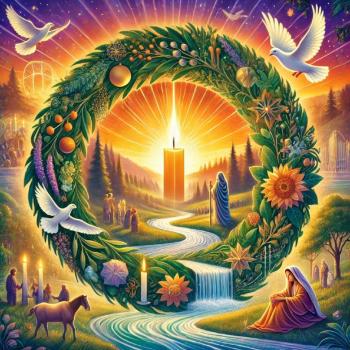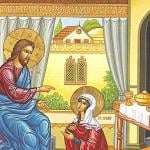The Adventurous Lectionary – The First Sunday in Advent – November 29, 2011
Jeremiah 33:14-16
Psalm 25:1-10
I Thessalonians 3:9-13
Luke 21:25-36
How do we feel as we look toward the future? Do we see continuity or discontinuity? Do we expect gradual evolution or cataclysmic change? Is the future filled with hope and fear, or a mixture? Will our galaxy – and planet – collapse when Andromeda galaxy and the Milky Way collide? Is there truth in the constant re-dating of the Second Coming of Jesus or is the Second Coming a myth reflecting the transformation of our planet, the healing of a ruptured and divided planet? Today’s scriptures suggest a multiplicity of possibilities, and whether the result of our own actions, divine-human companionship, or unilateral divine action, the future will bring change.
Jeremiah images hope in a naturalistic fashion. Like a branch springing forth with promise of fruit to come, God’s new era will emerge out of the people’s history and life experiences. God will fulfill God’s promises in ways that are continuous with God’s previous promises. God’s providence is naturalistic not catastrophic, consistent not chaotic. A branch grows from a tree, new life emerges from what was previously unhealthy. God’s healing of the earth and the people is gradual yet certain, building on the past and leaning toward an open future. God’s restoration of Shalom emerges from the world we live in and in accordance with its causal relationships rather than through a dramatic and supernatural intervention. The moral arc leans – and grows, we pray – toward justice. God’s fidelity is naturalistic. God mercies are new every morning, although some may be more dramatic than others. Still, God works within the world to bring forth God’s realm of Shalom. God is already here, there is no need for a supernatural and unilateral rescue operation undermining human fidelity and initiative.
Psalm 25 also looks toward the future in a naturalistic way. Our hope is God’s pathway of righteousness and peace. In lifting our hearts to God, trusting God’s way instead of our own devices and desires, we embody God’s future in our time. God leads us beyond a negative past toward healing and reconciliation. Like a good teacher, God painstakingly opens our hearts to the truth and shows us a road map to a joyful future. While we can choose pathways of destruction as well as divinity, following God’s path leads to fullness of life for us and our communities.
The prayer from I Thessalonians is affectionate and affirmative in tone. The evangelist is grateful his Thessalonian followers. They are running the race faithfully. But, more growth is possible, especially in an antagonistic social context. The evangelist prays for the Christian community and its members to grow in openness to God’s guidance, loving relationships, and spiritual maturity. While there may be mystical experiences and spiritual quantum leaps that radically transform our lives, the author imagines organic spiritual growth, building on previous experiences of faithful community and spiritual commitment. God is continually at work, not sporadically intrusive, guiding the steps of spiritual teachers and the communities that they nurture. The moral and spiritual arcs of God move through us, luring us forward, guiding our spiritual lives. Our hearts are filled with praise.
The “apocalyptic” passage from Luke’s Gospel has often been read in a supernatural manner. The Son of Man will return supernaturally in the clouds with power and glory. This rapture ruptures the world in which we live. Many commentators see this passage as a precursor to today’s “Left Behind” prophecies in which divine destruction is prelude to divine re-creation. Here the circle of hope is small and the circle of horror immense. According to those who claim insights into biblical prophesy, only a small portion of the earth will survive. The signs of the time herald destruction as well as redemption, and exacerbate the polarization already present our world. The saved and unsaved are separated eternally, one group to celebration, the other to judgment. But, in real life, is the separation of saints and sinners, believers and unbelievers, really that great? The one thing these end times prophecies have in common is that they have all been mistaken. Could it be that the datable Second Coming is one of the greatest hoaxes perpetrated in Christian history? End time prophesies are big business for televangelists and writers. Moreover they turn us away from our earthly responsibilities, turning us from key issues in climate change and justice.
Now, it is possible that catastrophe will overtake us. Our earth-destroying actions may reach a tipping point and instead of gradual deterioration, a dramatic change in weather patterns may occur. Our nation-first attitudes, emulated by a growing number of nations, may lead to complete chaos of world order, a survival of the fittest, abandoning any sense of interdependence and mutuality. In fact, we see the “signs of the times” in the impact of climate change through forest fires, drought, and hurricane. Will we see these signs and change our ways.
Still, the imagery of the fig tree, described in the second half of the reading suggests an alternative to apocalyptic. The revealing of God’s realm is more like the changing seasons than an unexpected tsunami. God’s providential response to both are fidelity and waywardness takes into consideration the world as it is, guiding it toward the best possible outcomes in the future. The moral arc is always luring us toward the future, but for the most part, its guidance is within the processes of life, and not external to our behaviors.
The adventurous preacher might ask, “What are the signs of the times that we can discern in our world today? What threats and hopes do these signs bring?” The message of the fig tree is that dramatic future events are grounded in the naturalistic process at work in the present moment. The future is in our hands as well as God’s. We cannot wait for a divine rescue operation or punitive catastrophe. We must do what is in our power to respond to God’s call to heal the earth.
We are the hands and feet and heart of God. We can be God’s companions in healing the earth. By our actions, we can promote a culture of life or death for ourselves and the planet. From this perspective, we need to look out for the signs of the time and not tranquilize ourselves with trivia. The signs of the times herald future scenarios, each of which is contingent on our commitments to God and the planet. For many, the signs herald ecological apocalypse. For others, our future, positive or negative, is unfolding gradually. Still, we must discern the signs of the times and respond in ways that heal the earth and its peoples.
Today’s readings open us to a divine destiny for our planet. They affirm that this destiny unfolds according to a dynamic divine-human partnership. In the creating the future, we are not omnipotent, but we also not impotent. We can tip the balance toward planetary health and open the door to greater influx of divine activity. We can choose intentional partnership with God to heal the earth.
+++
Bruce Epperly is a pastor, professor, and author of over sixty books including WALKING WITH FRANCIS OF ASSISI: FROM PRIVILEGE TO ACTIVISM; MYSTICS IN ACTION: TWELVE SAINTS FOR TODAY; PROCESS THEOLOGY: EMBRACING ADVENTURE WITH GOD; PROPHETIC HEALING: HOWARD THURMAN’S VISION OF CONTEMPLATIVE ACTIVISM; and 101 SOUL SEEDS FOR GRANDPARENTS WORKING FOR A BETTER WORLD. He is the author of three books on the twelve days of Christmas: THE WORK OF CHRISTMAS: THE TWELVE DAYS OF CHRISTMAS WITH HOWARD THURMAN; I WONDER AS I WANDER: THE TWELVE DAYS OF CHRISTMAS WITH MADELEINE L’ENGLE; and THIS PLACES EVERYWHERE: THE TWELVE DAYS OF CHRISTMAS WITH CELTIC CHRISTIANITY. He may be reached at [email protected].











